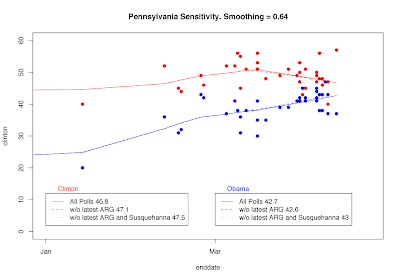
A new Newsweek poll gives Barack Obama a 54%-35% lead over Hillary Clinton among Democratic voters (
story here,
detailed results here, and thanks to Newsweek and their pollster, Princeton Survey Research Associates International, for a full and complete disclosure of the details of their survey. A model others should be encouraged to follow.)
The Newsweek poll raised a few eyebrows for its 19 point Obama lead, considerably more than other recent polls, and beyond the 10.4 point Obama lead in our trend estimator. However, a closer look at recent data shows that Newsweek is not far from other recent data. Newsweek is the 6th poll in April with Obama at or above 50%, while five April polls put him below 50%. With Clinton, Newsweek is the 4th April poll putting her at or below 40%, while eight polls have her above 40%. So Newsweek shows a larger Obama lead than others, but it is not as far out of line as may first appear. (Note in the counts of polls above, we only count independent samples of the Gallup daily tracker, so dont' count each of their daily results as new polls.)
As you can see from the plots below, we've not seen many recent outliers in the national Democratic nomination polling, and the new Newsweek is well within the 95% confidence interval.

All that said, our trend estimate for the race puts Obama at 50.2% and Clinton at 39.8%, a significant gain for Obama during the month of April. Since late March, Clinton has suffered a somewhat greater downward slope while Obama's gains have been a bit more shallow, implying a slight gain among undecided voters.
The Newsweek poll also has some interesting internal results. As with virtually all this year's polling, Obama has a substantial lead among Independents who will vote in the Democratic primary or who lean Democratic: 61% to 28% for Clinton. What is a key to Obama's strength in the Newsweek poll is he ALSO leads among self-declared Democrats 51% to 38%, a group Clinton has won in most contests. If real (and I want to see more data before I accept this change) then Obama may be winning the consensus among party rank and file that will be key to persuading Superdelegates to move strongly in his direction. So long as he trails among the strongest party identifiers, that case is less persuasive. Pennsylvania provides a new test of this possible change in support. (Obama continues to trail in our Pennsylvania estimates, so it is unlikely he has so far persuaded a majority of Democratic identifiers there, though stay tuned for Tuesday's exit polls.)
The other important shifts in this national Newsweek poll is that Obama leads among men 57%-31% but also among women 52%-38%. Again this would represent an important gain among women.
The age gradient in Obama support has been interesting all year. In the Newsweek poll, he wins 18-39 year olds by 62%-28%, as usual, but also wins 40-59 year olds by 54-36%. In past exit polls, his "break even point" has varied among age groups from as low as 40 (i.e. losing all groups over 40 years old) to as high as 59 (only losing those over 60 years old.). More astonishing here is he gains a plurality of those over 60, 47%-41%, which if true would be his best performance among older voters all year.
The area of the Newsweek poll where Obama still suffers is among working class or poor whites, where he trails badly, 35%-54%. In contrast he leads 52%-35% among upper and middle class whites. That class divide remains a critical issue for his campaign.
A caution here as well. In any poll with such high overall support, the support almost has to reach across many subgroups (not quite as a mathematical certainty, but as a strong empirical regularity.) So we should be careful not to accept the depth of Obama's support among Democrats, women and those over 40 years old until we have more evidence from additional polling. In the exit polls this year, where we see big Obama wins (VA, MD, WI) we also saw him making strong inroads among these groups. But with the margin he achieved in these states, it would have been hard NOT to have done well across groups. Be careful of the cause and effect attributions here. It is a challenging state like Pennsylvania that can reveal how deeply into the various demographic groups Obama has managed to extend his appeal. But with those cautions, Newsweek's poll shows some evidence that the national Democratic constituency is moving in his direction across a number of groups.
If these changes are real, we'll see new polling that reflects it. If just a favorable poll (though not an outlier!) then new polling will show that these groups are not quite as enthusiastic for Obama as the current poll suggested.

















